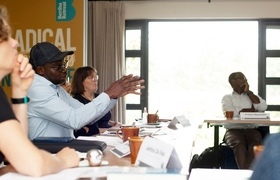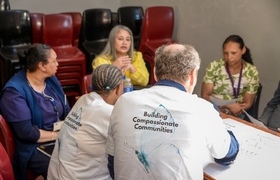UCT spearheading training and research for occupational lung disease in Southern Africa
30 December 2021 | Story Division of Occupational Medicine. Read time 4 min..jpeg)
They delivered a training programme on how to classify chest radiographs of workers with occupational lung disease according to the International Labour Organisation classification. The training was done under the auspices of NEPAD (New Partnership for Africa’s Development) and took place at the Occupational Health Centre of Excellence in Kitwe, Zambia.
In the global burden of disease estimates for Africa, silicosis comprised 32% of all pneumoconiosis (dust-related diseases), and new cases increased by 124% from 1990-2017. The highest global pneumoconiosis mortality and disability rates are found in Southern Sub-Saharan Africa.
Given this high disease burden, A/Prof Shahieda Adams, occupational medicine specialist in the Division of Occupational Medicine, and Dr Qonita Said-Hartley, consultant radiologist and Head of Clinical Unit of Radiology at Groote Schuur Hospital, spearheaded an interdisciplinary African collaboration to promote capacity for the detection of pneumoconiosis. They delivered a training programme on how to classify chest radiographs of workers with occupational lung disease according to the International Labour Organisation classification. The training was done under the auspices of NEPAD (New Partnership for Africa’s Development) and took place at the Occupational Health Centre of Excellence in Kitwe, Zambia.
Participants were doctors from Zambia and Malawi engaged in providing clinical services to mineworkers exposed to mine dust. The Malawian delegation was headed by Dr Yotam Moya, an MPhil (Occupational Health) UCT graduate currently developing a national OHS system for Malawi. The Occupational Medicine Division is also training one of Malawi’s first occupational medicine specialists, Dr Phinias Mfune, currently based at UCT.
This training comes on the back of the sterling work done by Dr Botembetume Maboso, an MPhil (Occupational Health) student, who was recently awarded the EPICOH Early Career Award for his research on the value of chest radiographs as a diagnostic tool for detecting TB in ex-miners in Lesotho. He has been involved in training local health professionals on the assessment and management of occupational lung disease in mineworkers.
Another PhD student, Dr Paulino Chamba, a medical officer at the Centre of Medical Examinations in Maputo under the National Health Ministry of Mozambique also graduated last year. His research focussed on work-related asthma among workers in the Mozambique wood processing industry.
Reflecting on the achievements of the Occupational Medicine Division, Prof Mohamed Jeebhay commented that the long-term sustained efforts of the Division in the past two decades, supported by grants from the NIH and the Fogarty International Centre and now thorough NEPAD, certainly bearing fruit. These partnerships bode well for interdisciplinary work and boosting occupational health capacity in Africa. The Division was recently approached by International SOS to develop a distance training programme on occupational health for primary care doctors and nurses in Africa over the next two years.
 This work is licensed under a Creative Commons Attribution-NoDerivatives 4.0 International License.
This work is licensed under a Creative Commons Attribution-NoDerivatives 4.0 International License.
Please view the republishing articles page for more information.










